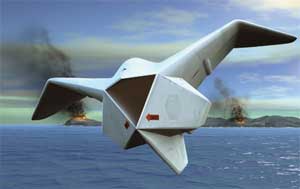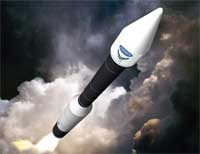Hard on the heels of its July unveiling of the Polecat high altitude research UAV, Lockheed Martin has revealed plans for a diverse range of new unmanned combat aircraft — some bordering on the exotic.
 Among them are an unmanned combat aerial vehicle (UCAV) variant of the F-35 Joint Strike Fighter, a fan-in-wing vertical take-off and landing aircraft known as the Various, a morphing-wing Hunter-Killer, the submarine-launched Cormorant and a hypersonic “deep strike” aircraft called the Falcon. Among them are an unmanned combat aerial vehicle (UCAV) variant of the F-35 Joint Strike Fighter, a fan-in-wing vertical take-off and landing aircraft known as the Various, a morphing-wing Hunter-Killer, the submarine-launched Cormorant and a hypersonic “deep strike” aircraft called the Falcon.
“This, along with the Polecat, is our way to get back into the unmanned systems business,” said Frank Mauro, director of UAV programs at Lockheed Martin’s Advanced Development Programs unit in Palmdale, Calif., otherwise known as the Skunk Works. “A little of it is playing catch-up; a little of it is leapfrogging forward.”
First up may be the pilotless F-35, which Mauro described as Lockheed Martin’s way of compensating for its absence from the Pentagon’s Joint Unmanned Combat Air Systems (J-UCAS) bid, which aims to provide unmanned strike aircraft for the U.S. Air Force and U.S. Navy.
In operation, manned F-35s would control up to four UCAVs through an aerial wireless Internet setup, Mauro said. This would eliminate the need for satellite communications while allowing the removal of sensors from the drones, which would serve solely as bomb carriers.
Initial plans show the unmanned F-35 retaining its cockpit and canopy, though a follow-on version would eliminate those features and use the space for additional fuel.
“We’re focused on our manned F-35 now,” Mauro said, “but will pick up the unmanned version as interest among the military grows. And, unlike J-UCAS, we have a vehicle flying now.”
Development of the Various, a ducted-fan UAV capable of vertical flight, is at an earlier stage. This aircraft is slated to meet a naval requirement for a 6,000-to-8,000-pound vehicle to replace the Firescout, a UAV based on a light civil helicopter. Wind tunnel testing of Various models is underway, Mauro said, and several wing configurations, including morphing and/or telescoping, are under consideration.
Adjustable wings are a key aspect of the Hunter Killer UCAV, which aims for the ability to dash like a strike aircraft but loiter like a dedicated reconnaissance platform. Achieving a four-to-one ratio between the high speed and the low-end is the goal, Mauro said.
Lockheed Martin is partnering with the U.S. Defense Advanced Research Projects Agency (DARPA) on Morphing Vehicle technology, and plans are to use a small demonstrator to prove that in-flight control can be maintained during the shape-shifting process. Subsequent tests with a larger vehicle are expected to evaluate this approach under mission conditions.
 Cormorant, a stealthy, submarine-launched UCAV powered by a pair of Tomahawk cruise missile engines, is also in its first phase. Engineers are seeking to prove that this vehicle — also with morphing wings — can be launched from the missile silo of a converted ballistic missile submarine, fly a mission, and be recovered, perhaps by an unmanned underwater vehicle (UUV). Cormorant, a stealthy, submarine-launched UCAV powered by a pair of Tomahawk cruise missile engines, is also in its first phase. Engineers are seeking to prove that this vehicle — also with morphing wings — can be launched from the missile silo of a converted ballistic missile submarine, fly a mission, and be recovered, perhaps by an unmanned underwater vehicle (UUV).
“They want to see if they can seal the vehicle, crash it into the ocean and get it back into the tube,” Mauro said, adding that the aircraft will land in the water with its wings in the extended position.
 Falcon, the hypersonic UCAV, addresses an anticipated Air Force requirement for an unmanned “deep strike” aircraft able to reach anywhere in the world from the continental U.S. in two hours or less. Propulsion is the key to this capability, and Falcon is slated to employ turbine engines that morph into supersonic combustion ramjets, or Scramjets. Falcon, the hypersonic UCAV, addresses an anticipated Air Force requirement for an unmanned “deep strike” aircraft able to reach anywhere in the world from the continental U.S. in two hours or less. Propulsion is the key to this capability, and Falcon is slated to employ turbine engines that morph into supersonic combustion ramjets, or Scramjets.
Designed around a weapons load of around 16,000 pounds, this Boeing B-52-sized drone could one day fly for 5 hours at Mach 10 (7,612 mph) at the edge of space. So far, the only publicly-revealed aircraft to achieve this speed range is NASA’s X-43A experimental aircraft, which used Scramjet power to reach Mach 9.6 in November 2004.
“These are the dreams we’re putting our money on,” Mauro said.
|